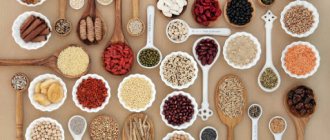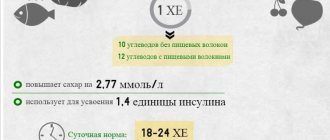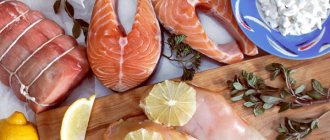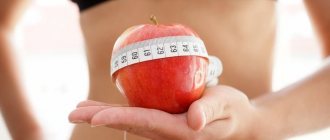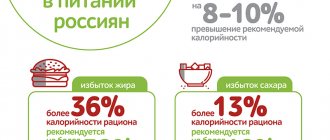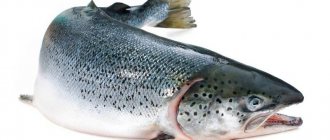Research shows that almost half of Europeans do not read labels on the products they buy. Have you looked at what is written on the packaging of your favorite sauce, yogurt or even bread? Sometimes you can read very unexpected information there.
Choosing healthy and natural products is not an easy task. In recent decades, there has been a noticeable increase in interest in a healthy lifestyle and healthy food in the world, and marketers are taking full advantage of this “weakness” of consumers. Advertising convinces us that this particular product is “the most natural”, “without preservatives”, “rich in vitamins” and “low-calorie”. How to check the quality of a product by its label and how to find out how much truth there is in advertising slogans?
General requirements for product labeling
Content:
- General requirements for product labeling
- Mandatory information on the label
- How to understand what a product was made from
- How to decipher the nutritional value of a product
- What to pay special attention to when reading the label
- What do the additional inscriptions on the label say?
- Pasteurized and sterilized: which is better?
- What's in the picture
All countries have strict requirements for food labeling. This is done to protect the buyer. Another question is that not all consumers know exactly what, how and where manufacturers should indicate about their product.
The first reason why many are hesitant to read labels is that the font is very small. And at the same time, buyers often do not even realize that unreadable labels on the product are a violation on the part of the manufacturer. According to legislation (not only Russian, but also other countries), labeling on products must be easy to read and not mislead the buyer. Secondly, all markings are applied in a color contrasting with the background. Thirdly, text and special symbols must be applied with high-quality paints and not be erased during the entire shelf life of the product.
Best before date
Be sure to check the expiration date of the product, as stores often continue to offer the product for sale even after the expiration date. Such goods or those whose expiration date will soon expire, as a rule, are placed at the beginning of the product shelves at arm's length, therefore, if you do not plan to use this or that product in the near future, you should not be lazy to take goods located in the depths of the product shelves . Avoid purchasing products with a long shelf life, they contain preservatives; the healthiest product will be the one that has a short shelf life and contains minimal amounts of various additives.
Mandatory information on the label
Directly on the packaging there should be information about the name of the product, its expiration date and storage conditions, as well as the presence of components that can cause allergies. The remaining information can be placed on an additional leaflet (if the packaging area does not allow for all the statements to be placed). In addition, from a properly designed label, the consumer can find out the quantity of the product in the package, its composition and nutritional value, as well as obtain information about the manufacturer and packer. The packaging itself should have a pictogram in the form of a glass and fork. This designation ensures that the container is made of material intended for storing food.
Product name
The name of a product is not its name at all, as some may think. According to the rules, the name must clearly and reliably characterize the product, indicating only those components that are included in its composition. That is, based on this information on the label, the buyer should understand what kind of product is in front of him.
For example, the name “raspberry yogurt” indicates that the product contains berries (whole or chopped). If the composition contains appropriate flavorings or flavoring additives instead of natural raspberries, then this should also be reflected in the name: “yogurt with the aroma (taste) of raspberries.”
In meat products, everything should also be clear. For example, “homemade cutlets” is not a name, but the name of a product. The correct name should sound something like this: “semi-finished product formed from minced broiler meat.” In meat products, this label item must indicate from what grade and type (chilled, ice cream) raw materials the product is made.
Quantity
A properly designed label should contain information about the amount of product in the package (in g/kg, ml/l or pieces). If the container contains a product immersed in liquid, the manufacturer must indicate the mass with and without liquid. As an example, you can take mozzarella cheese in brine. The correct label will indicate the number of cheese balls in the package, the weight of each of them and the total weight of the product with liquid.
Compound
This is perhaps the most interesting and most important part of the label for the buyer, which we will talk about in more detail a little later. In the meantime, let us remind you that in the list of ingredients the components should be listed in descending order of their mass fraction in the product. That is, the finished product always contains more of the ingredient that is mentioned first in the list.
The nutritional value
Canadian researchers have calculated that people who pay attention to this label column weigh on average 4 kilograms less than those who are not interested in the energy value of purchased food. What characteristics of a product, in addition to calories, should be indicated on the label and what they can tell about the nutritional properties of the product, we will consider in more detail in the following sections.
Expiration date and production date
For products whose shelf life does not exceed 72 hours (for example, bread), the date of manufacture must be indicated in the format: time, day, month. If the shelf life of the product is from 72 hours to 90 days, then the manufacturer can use the format: date, month, year. Only the month and year of production can be indicated on food products whose shelf life exceeds 3 months.
Manufacturer information
In addition to the manufacturer's name, the correct label must also include its address. Moreover, if the company is officially registered at one address, and the production building is located at another, then both must be on the packaging. The same rule applies to imported goods.
Composition per 100 grams or per serving
The composition is usually indicated per 100 g of product. The package may contain more or less than this amount. Therefore, the content of certain ingredients will have to be recalculated to the actual weight of the package. Sometimes the composition of a product is indicated per serving, usually weighing less than 100 g, and there may be several of them in the package. In this case, you need to carefully look at how many servings the package contains and how to measure them. Always pay attention not only to the composition of the product, but also to the weight of the package and the number of servings in it.
How to understand what a product was made from
Order matters
To understand what a purchased food consists of, you need to carefully study the list of ingredients, which is a mandatory element of the labeling. But strangely enough, not everyone understands how to correctly decipher this information. If an ingredient is mentioned in the list of components, this does not mean that it occupies a large mass fraction in the finished product.
Take, for example, yoghurts with the addition of berries or fruits. This is one of the most popular products in the dairy departments of stores. But different manufacturers can use different amounts of fruit and berry filler (some have 70%, others have 7, and others have not even 0.7%), which ultimately, of course, affects both the taste and beneficial properties of the product . Or let's take another example - beef sausages. If the list of ingredients mentions beef, this is not an indication that the product consists entirely of this meat. In fact, there may be a tiny portion of it in sausages. However, don't assume that grocery shopping is like a lottery and there's no way to know what's inside until you try. All information is indicated on the label, the main thing is to be able to find it.
So, in order to learn how to choose truly high-quality products, you need to remember the first rule: all ingredients in the composition are listed in order of decreasing quantity. That is, if soy, chicken and other components are mentioned in the first positions in the composition of beef sausages, and beef is closer to the end of the list, then we can say that it is almost absent from the product. In good beef products, this type of meat should come first. And this rule applies to all purchased food.
By the way, the long list of ingredients should also alert you. As a rule, the longer it is, the less natural the food is, since one natural ingredient usually has to be replaced with several chemical analogues. For example, natural juice, which would be one item on the list, can be replaced with the following set: water, sugar (or artificial sweetener), flavor identical to natural, stabilizer, antioxidant, acidity regulator, preservative. The taste of a natural and chemical product may even be very similar, but the body will not receive any benefit from the artificially created juice.
What ingredients are prohibited from being kept silent?
Some components, even if they are present in the product in the smallest portions, must be listed in the ingredients list. We are talking about peanuts, nuts, mustard, cereals with gluten, milk (lactose), shellfish and crustaceans, fish, sesame, lupine, celery, soy, eggs, as well as aspartame and sulfites (if more than 10 mg per 1 kg or 1 l). All of the ingredients listed are known to be strong allergens, hence the increased attention to them.
By the way, attentive buyers have probably noticed on some labels that the product may contain traces of grains, nuts or lactose, although, in fact, they should not be there. This is done in cases where allergenic components are, in principle, used in production, even for the manufacture of other products.
Dangerous "E"
Food additives, so-called E-additives, are present in greater or lesser quantities in almost all food products. In the list of ingredients they may be referred to as E with the corresponding index or named according to their functional purpose (stabilizer, acidity regulator, emulsifier, etc.). As for additives from the group of flavorings, they should always be mentioned with an explanation.
In addition, according to the rules, the product label must contain information about the content of sweeteners, sweeteners, the food additive aspartame, as well as dyes E102, E104, FCF E110, E122, 4R E124 and AC E129. According to research, these dyes can cause hyperactivity and attention deficit disorder in children.
By the way, it is useful to remember the classification of E-additives. At least in general terms. For example, E with an index starting at 1 is usually dyes, 2 - preservatives, 3 - antioxidants, 4 - stabilizers, 5 - emulsifiers, 6 - flavor and odor enhancers.
But not all of them are dangerous. For example, dye E160 is regular paprika. Preservatives are added to food to extend its shelf life. The completely safe ones are salt, malic and citric acids. In addition to them, other preservatives are often used in products, for example, benzoic or sorbic acid (less harmful). As for emulsifiers, these additives give foods a rich and smooth texture. The most common and completely safe emulsifier is lecithin, which is obtained from egg yolk.
However, some E can cause serious health problems. The most dangerous:
- E103, E105, E121, E123, E130, E152, E330, E447 – can cause cancer;
- E230, E231, E239, E311, E313 – lead to allergies;
- E221, E226, E338, E341, E462, E66 – cause disruptions in the digestive system;
- E171, E173, E330, E22 – harm the liver and kidneys.
The presence of any of these components in the list of ingredients is a serious reason to wonder whether you need such a product.
Does the product contain salt?
Doctors say that you can consume no more than 1 tsp per day without harming your health. (about 5 g) salt. Excessively salty foods are especially harmful for people with heart and kidney diseases. Salt on the label of purchased food may be mentioned under two names: salt itself or sodium (5 g of salt is 1.5-2 g of sodium). If the list of ingredients does not indicate the exact amount of salt, then this indicator can be approximately determined by the same order of mentioning the components.
What you need to start working with labeled products
Product labeling is a headache not only for the manufacturer, but also for the retailer, because the withdrawal of products from circulation and the transfer of information to Chestny ZNAK rests with him, i.e. The retail store is the final link in the product labeling process. The effectiveness of the marking itself depends on how conscientious all elements of the marking chain are. In order to work with labeled goods, a retail store needs:
- Get an electronic digital signature.
- Register in the Chestny ZNAK system.
- Purchase equipment for labeling (as some goods can be labeled by the retailer, for example, remnants of goods for which mandatory labeling has already been introduced).
- Connect to the fiscal data operator and its corresponding service for working with labeling.
- Connect the EDF service for receiving and transmitting UPD.
- Set up an online cash register that supports the FFD 1.2 fiscal data format.
- Instruct employees on how to work with labeled products.
How to decipher the nutritional value of a product
The energy value of a product can be indicated in kcal or kJ. In addition, the label must contain information about proteins, fats and carbohydrates, vitamins and minerals per 100 g (ml) of the product. If the proportion of these components does not exceed 2% of the daily value for an adult, then they may not be indicated on the label. The nutritional value of semi-finished and raw foods is indicated without taking into account cooking and also per 100 g, and not per serving, as some buyers mistakenly think.
In imported products, in addition to the total carbohydrate indicator, information about the sugar content is included separately on the label. This allows you to control your sweet intake. A product with a minimum amount of simple sugars (sucrose, fructose, glucose) and a higher amount of complex carbohydrates (found in cereals) is more beneficial for the body. If sugar is mentioned first in the list of ingredients, this means that this is a product with a large amount of fast carbohydrates, which means it is not the healthiest. Excess sugar is often found in sweet sodas, juice drinks, nectars, muesli, instant cereals, and cereal bars. At the same time, you should not place high hopes on products labeled “sugar-free.” In such products, as a rule, sugar is replaced with synthetic sweeteners or fructose.
There are three types of fats in food: unsaturated, saturated and trans fats. For a healthy diet, unsaturated fats are the most beneficial; other types should be avoided. Trans fats can be found in large quantities in margarines, spreads, and cheap confectionery products. By the way, if the label says that this is a low-fat product, this does not mean that it is healthy. Firstly, it is not safe to completely give up fat. And secondly, store-bought foods without fat can often contain more calories due to the addition of carbohydrates.
Special mention should be made about “cholesterol-free” products. Often this kind of inscription is a common advertising ploy. But what is most absurd is that sometimes it is written on products that cannot contain cholesterol. Cholesterol is found only in products of animal origin. So “cholesterol-free” vegetable oil sounds ridiculous, even though from a marketing point of view it attracts the attention of unknowing buyers. But if there is an inscription about the absence of cholesterol on butter, this can have two explanations. Either the butter contains cholesterol, or it is not butter at all, but cheap margarine with vegetable fat.
Cheese or cheese product, how to distinguish and what to choose?
Pay close attention to the names of the products themselves; not so long ago, veiled names “cheese product”, “milk-containing product”, “kefir product” and others began to appear on store shelves. In appearance, this is the same ordinary cheese as we are used to seeing, with the same bright packaging, but be very vigilant, often in very small print, where “cheese product” will be written somewhere in an inconspicuous place, thus, manufacturers are trying to deceive us.
Cheese is a dairy product, and a cheese product is a milk-containing product. What is the difference? Everything is very simple, a dairy product is made directly from milk and its components, while a milk-containing product contains only a small percentage of milk (at least 20% of dry substances), and the rest is not milk fat or milk protein. That is, vegetable fat, which is subjected to many different treatments, after which it becomes chemically active. When such a product enters the body, processed fat reacts with cells, destroying tissue, the nervous, cardiovascular and immune systems. Also, the consumption of this type of product has a detrimental effect on the reproductive system, both in women and men.
What to pay special attention to when reading the label
In 2021, Roskontrol, as part of the special project “Label without deception,” checked several thousand products in the most popular retail chains in Russia.
It turned out that on average 60% of products have false information on their labels.
Milk without milk
Experts identified the most discrepancies in the dairy departments. Manufacturers often try to sell so-called cheese-like products containing palm oil under the guise of cheese. What is in reality a spread or cooking fat can be called “Krestyanskoye”, “Slivochnoye”, “Grilled”, “Derevenskoye” by some brands and is perceived by customers as familiar butter. But if you are not lazy and read the smallest inscriptions, you can find out that this is not natural oil at all, but something containing palm and trans fats, preservatives, emulsifiers, dyes, flavors and sweeteners. In cottage cheese, ice cream, condensed milk and cheese desserts, instead of the milk fat customers expect, you can find its vegetable substitutes. By the way, to avoid liability, manufacturers often use cunning tricks with names. For example, condensed milk is called “Condensed milk”, cottage cheese is called “Tvorozhkom”, instead of “Butter” they simply write “Butter” on the label. So buyers should pay special attention to reading the list of ingredients in products with similar tricky names.
Non-child food
According to the rules, margarine is strictly forbidden in products intended for children, but most confectionery products that children like so much contain vegetable fats. And candy and carbonated drinks almost always contain dangerous dyes.
But this is not the biggest deception yet. Separately, it should be said about the so-called pseudo-baby food. It is enough for the manufacturer to decorate the label with a cartoon character or a photograph of a child so that the buyer automatically perceives this product as part of baby food. In fact, if you carefully read the composition and name of the product, it will become clear that this product has nothing in common with baby food, but on the contrary, contains additives that are dangerous for babies.
Tricks with components
Having studied the assortment of many stores, Roskontrol experts identified sausages called “Beef”, which contained less than 2% of the total composition of beef. And in the sausage, called , boar meat is not mentioned at all in the list of ingredients. In addition, experts everywhere found the already mentioned berry yoghurts without berries, pomegranate juice, in which there is no more than 1% pomegranate, oatmeal cookies with virtually no oats, peanut butter, in which there are less than 50% peanuts, and even rye bread, in which there is far less rye flour. less than the buyer might think.
What does "Cholesterol Free" mean?
This advertising slogan is sometimes placed on products that never contained cholesterol in order to attract additional attention. For example, it is not found in any vegetable oils, since cholesterol is a product of exclusively animal origin. Cholesterol-free foods are not necessarily very healthy. For example, there is no cholesterol in spreads made from vegetable oils, many confectionery fats and cheap margarines. These foods are high in calories and contain trans fats. Treat advertising slogans on packaging with healthy skepticism and pay more attention to the composition.
What do the additional inscriptions on the label say?
Many consumers carefully select products whose labels indicate that they do not contain certain ingredients or contain lower amounts of them. At the same time, consumers do not even realize that these labels should not be trusted too much.
A “healthy” food label simply means that the food contains less fat, sodium, and cholesterol than similar foods. The designation “Does not contain” does not always mean the complete absence of a component. For example, if a product “does not contain trans fats,” then in fact there may be trans fats, but not exceed 0.5 mg. A “cholesterol-free” food may contain up to 2 mg of cholesterol and up to 2 g of saturated fat. And “low cholesterol is up to 20 mg of cholesterol and 2 g of saturated fat.
“Low sodium” means that there is no more than 140 mg of sodium in the product, and “low fat” is written on food that contains up to 3 g of fat. Typically, “low content” indicates that the ingredient in the composition is about a quarter less than normal. If a product is labeled as “light,” it should have half the fat or a third less calories.
Contact details of the manufacturer and/or importer
The state standard obliges to indicate on the labels the brand name of the manufacturer, seller and performer, their addresses and contact information. This was done, first of all, to protect the market from low-quality products and to be able to contact responsible manufacturers.
If the product is imported, then the label must contain information in Russian: the country of manufacture (or country of origin) must be indicated. Information about the country of origin is also contained in the barcode.
Pasteurized and sterilized: which is better?
Best materials of the month
- Coronaviruses: SARS-CoV-2 (COVID-19)
- Antibiotics for the prevention and treatment of COVID-19: how effective are they?
- The most common "office" diseases
- Does vodka kill coronavirus?
- How to stay alive on our roads?
On various drinks you can see inscriptions about pasteurization or sterilization of the product. Often, buyers do not understand what this marking means and how pasteurized milk differs from sterilized milk. The label “pasteurized” indicates that the product has been cooked at temperatures below 70 degrees. As a result, the dangerous bacteria in it died, but the beneficial substances remained. Sterilization is carried out at 100 degrees and above. The advantage of this treatment is a longer shelf life than pasteurized products. Disadvantage: after sterilization, the amount of nutrients is reduced by 2 times.
Organic eggs
Since we're talking about chickens, let's talk about eggs. If you are not careful here, you can easily fall into the trap of scammers, and even worse, unknowingly support a manufacturer who practices cruelty to animals.
- An organic product means that the birds that lay eggs are not kept in a cage, but, as a rule, in a large barn. They have access to the outdoors, but there are no clear rules dictating how long the birds should be outdoors. In addition, the birds are subjected to beak trimming and forced molting (through starvation).
- Free range - as mentioned above, this means that laying hens have access to the outdoors, but there are no rules governing the length of their stay in the fresh air.
- Cage free sounds very friendly, but in reality everything is not what it seems. Indeed, the birds are not kept in cages; instead, they live indoors without access to the outdoors.
- Humane treatment (Certified Humane) means that the birds live, although not in cages, but still in captivity. Forced shedding is allowed.
- Animal Welfare Approved is the best option available. This means that the animals are not kept in cages and always have access to the outside. In addition, they are not subject to forced beak trimming and forced molting.
What's in the picture
Which product will you choose: in nondescript packaging with inscriptions in a strict font or in bright containers decorated with photographs of mouth-watering dishes? That's it! And if you look closely at the store windows, it becomes clear that the manufacturers have started a real label war among themselves. One is more beautiful than the other! They beckon to you, whet your appetite and... often do not comply with the design rules. According to legal regulations, the label cannot depict a dish that does not use the product being sold. But there is one nuance in this rule that often confuses buyers. Let's return to the already mentioned yogurt with raspberry flavor. So, in this case, the legislation does not prohibit the manufacturer from drawing on the packaging ingredients that have been replaced in the product by the corresponding food additive. That is, on a product that actually does not contain any raspberries, the berry can still be drawn on the packaging. Therefore, to understand what is actually contained inside, you should not look only at the picture, it is important to carefully read the list of ingredients.
We are what we eat. Our health, appearance and ability to work largely depend on what goes on our plates. Do you know what you actually eat, how healthy it is and what “natural” food from the supermarket consists of?
More fresh and relevant information about health on our Telegram channel. Subscribe: https://t.me/foodandhealthru
We will be grateful if you use the buttons:
Nutritional supplements
If you look at the list of food additives, there are approximately 1.5 thousand items. Each E-shka is a separate substance with its own properties and effects on the body. Among them there are quite safe and familiar ones. Thus, index E has beta-cathorin E160, citric acid E330, modified starch (not to be confused with GMOs) E1400-1450, completely harmless gums (guar, xanthan) E400-419. Even oxygen, which is used for packaging, is designated as E948. So E-shka is not always “terrible chemistry”.
Also, one should not lose sight of the fact that flavorings are not marked with E indexes: there are so many of them that the numbers are not enough.
Preservatives, emulsifiers, stabilizers...
Preservatives are necessary to spread bacteria and prevent food spoilage. The most common are benzoic and sorbic acids. Moreover, sorbic acid is preferable and more natural than benzoin. It would be better if the preservatives contained only citric acid, malic acid or salt.
Emulsifiers are most often used in cases where it is necessary to create the effect of a fatty smooth texture from low-fat products. The most common emulsifier is lecithin. An acceptable supplement that may even be beneficial. It is also found in natural products. For example, in egg yolk.
I hope this information will make you look at the ingredients of your products more often, and you will understand how important it is to read food labels! If you have any questions about any components, write them in the comments. Let's try to figure it out!
If you find an error, please select a piece of text and press Ctrl+Enter.
How to find trans fats?
Trans fats are formed during the production of margarine from vegetable oil, most often palm or other cheap oil. This component is our enemy No. 1. Its consumption must be strictly limited, because In addition to excess weight, it can bring us many diseases.
Unfortunately, in Russia there are no requirements for manufacturers to indicate the amount of trans fats. But mentioning them in the composition should alert you, especially if they are close to the top of the list.
Where is trans fat found? In many cookies, sweets, cakes, margarines, vegetable creams, chocolate spreads, ice cream... Of course, not in all, but mainly in cheap ones. Therefore, it is better to buy 1 pack of good cookies than to poison yourself with inexpensive products with vegetable fats.
Sasha and I still remember delicious, high-quality Italian ice cream. We ate enough for the year ahead in 3 weeks of travel..))
Organic meat
There are only 3 real labels certifying organic meat:
- An organic product means that the animals are grazed for at least 120 days and do not receive antibiotics.
- Grass fed - the stomach of most animals is adapted to digest plant foods and the rest of the food is difficult for them to digest. The grass fed label means that this meat product is healthier and more natural.
- 100% grass fed means that the animal had unlimited access to pasture and received only natural nutrition.
Read the labels carefully and don’t be fooled - for the sake of your health, the safety of your wallet and to be sure of the welfare of the animals!
